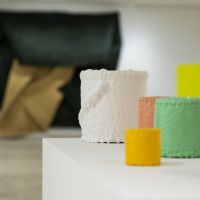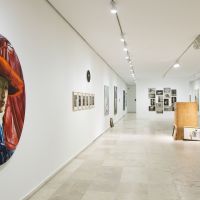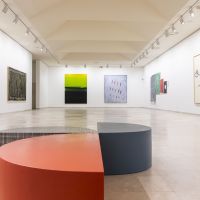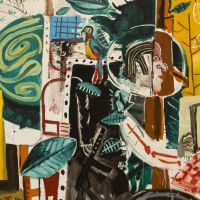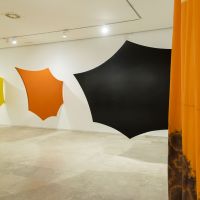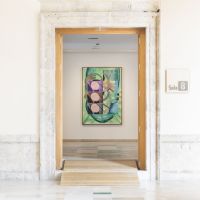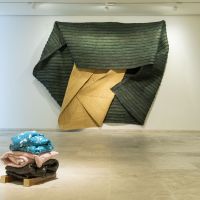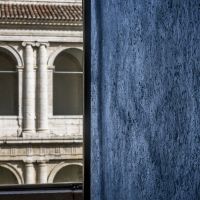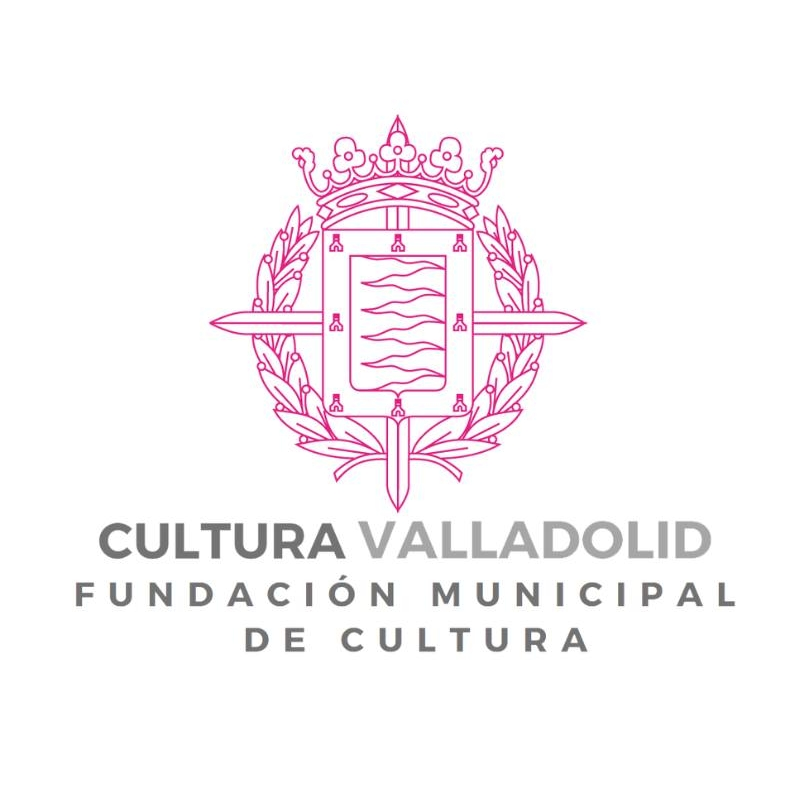PINTURA. RENOVACIĂN PERMANENTE
Comisario: Mariano Navarro
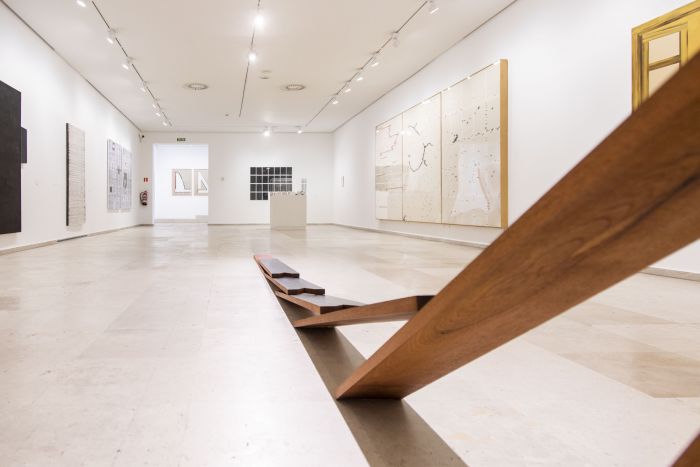
[English version below]
La exposiciĂłn Pintura. RenovaciĂłn permanente pretende arrojar luz sobre dos momentos de enorme importancia en el marco de la pintura contemporĂĄnea española que permitieron a este medio recuperar la relevancia perdida tras el predominio crĂtico y expositivo de otros lenguajes diferentes, mĂĄs o menos lejanos. Estos son, por un lado, los años bisagra entre finales de los años sesenta y la dĂ©cada de los setenta y, por otro, el ocaso de los noventa y los albores del nuevo siglo, cuyas energĂas permanecen vigentes en nuestros dĂas.
En el primer momento, ligado al tardofranquismo, un nutrido grupo de pintores, que salvo excepciones no compondrĂan grupos orgĂĄnicos, asumieron que la pintura podĂa compartir el territorio de investigaciĂłn del arte conceptual, a la vez que enunciaba nuevos paradigmas, como la progresiva indistinciĂłn entre abstracciĂłn y figuraciĂłn o la disoluciĂłn de la lĂnea cronolĂłgica entre la historia del arte reciente y la del pasado. Esto les permitiĂł habitar ĂĄmbitos referenciales como el expresionismo abstracto, el minimal y post-minimal norteamericanos, la figuraciĂłn derivada de la influencia de CĂšzanne y de Matisse, y una relectura desenfadada de los referentes histĂłricos de la AntigĂŒedad.
En el segundo momento, ya a finales de los noventa y en el arranque del nuevo siglo, se produce un nuevo impulso de la pintura, heredero del que disfrutaron los artistas de los setenta, que, como decĂamos, apostĂł tanto por una prĂĄctica desenfadada de los modelos histĂłricos de abstracciĂłn y figuraciĂłn âsin reparo alguno a su fĂłrmula narrativaâ, como por una prĂĄctica expandida de la pintura misma y su significado.
Nuestro énfasis en estas dos épocas entra en contradicción con una muy extendida tesis que afirma que el momento triunfal de la pintura en España fueron los años ochenta, en los que, si bien ciertamente el mercado del arte alcanzó una notable relevancia social, no asistimos a una mayor incidencia, ni inventiva ni transformadora. De hecho, en su obsesión del sistema del arte español por evocar lo foråneo, se negaron otras tendencias locales mås notables.
Pintura: RenovaciĂłn Permanente ofrece, por tanto, un ensayo crĂtico a la vez que una mirada de rango histĂłrico a lo sucedido en la pintura en España, que se sustenta en esos dos momentos especialmente poderosos. En ella comparten espacio algunos de los nombres fundamentales de los setenta, sin buscar jerarquĂa alguna, con los artistas alumbrados por el nuevo siglo.
La muestra se organiza en un amplio recorrido articulado en torno a capĂtulos o apartados en los que se abordan las que a nuestro juicio son las lĂneas mĂĄs intensas en las que los y las artistas han desarrollado su trabajo, como la âdesmaterializaciĂłn de la pinturaâ, âlos nuevos modos de la abstracciĂłnâ, âla pintura en el campo expandidoâ y dos vertientes de la figuraciĂłn, la que podemos considerar como voluntariamente âa-representativaâ y la figuraciĂłn ânarrativaâ.
La exposiciĂłn tiene lugar en las plantas segunda y tercera, esto es, las salas 3, 4, 5, 6, 7 y 8, si bien se derrama hacia otros espacios como el claustro de la planta baja, con la intervenciĂłn de Ignasi AballĂ que evoca aquella realizada por el mismo artista en un contexto radicalmente diferente, la muestra colectiva Intocable: El ideal de la transparencia, celebrada en el Museo en 2007. El artista Carlos MaciĂĄ darĂĄ contexto a los cuadros de Soledad Sevilla que pueden verse en el distribuidor de la planta baja con una intervenciĂłn de lĂneas y, ademĂĄs, ocuparĂĄ los vidrios del ventanal de la fachada a travĂ©s de un patrĂłn geomĂ©trico que constituirĂĄ la imagen de la exposiciĂłn.
SALA 3. Pintura expandida
Las obras que pueden verse en la vecina Sala 4, dedicada a la desmaterializaciĂłn de la pintura, funcionan, en cierto modo, como prĂłlogo o apertura de las que pueden verse en este espacio, la Sala 3, donde observamos uno de los fenĂłmenos mĂĄs contundentes de la pintura contemporĂĄnea: su expansiĂłn hacia campos y territorios que la vinculan a otras prĂĄcticas, como la escultura o la arquitectura, a la vez que la reafirman en su fundamento y esencia.
En su cĂ©lebre ensayo La escultura en el campo expandido, la cĂ©lebre historiadora estadounidense Rosalind Krauss advirtiĂł que âa travĂ©s de la fetichizaciĂłn de la base, la escultura se dirige hacia abajo para absorber el pedestal en sĂ misma [âŠ] Y a travĂ©s de la representaciĂłn de sus propios materiales o el proceso de su construcciĂłn, la escultura muestra su propia autonomĂaâ. Tal vez podrĂamos afirmar ahora que a travĂ©s de la fetichizaciĂłn de la crĂtica de la superficie, de las dos dimensiones, la pintura se abre espacialmente a los modos mĂĄs radicales de su ensanchamiento y dispersiĂłn. Y desprendiĂ©ndose de todos los modos de la tradiciĂłn, muestra su propia autonomĂa.
Confluyen, pues, en esta sala, obras de autores hoy clĂĄsicos como Mitsuo Miura o Santiago Serrano, quienes desde distintas posiciones y culturas coinciden en explorar la incipiente posibilidad del volumen en la pintura, con otros creadores, mĂĄs jĂłvenes, que indagan mĂĄs allĂĄ del concepto de lo pictĂłrico y acuden a materiales que llevan la pintura a otra dimensiĂłn.
Miren Doiz, por ejemplo, explora esta dimensiĂłn hasta sus lĂmites. âSiempre con la pintura como eje fundamentalâ âdiceâ, âmi trabajo se sitĂșa entre lo pictĂłrico, la instalaciĂłn y la fotografĂa. MĂ©todo que en su translaciĂłn plĂĄstica obtiene como resultado una amalgama que subvierte la observancia de las reglas, ya sea en el acto de creaciĂłn como de afectaciĂłn en la visualizaciĂłn de la obraâ.
Francisco Javier San MartĂn considera que las telas teñidas y abrasadas de BelĂ©n RodrĂguez âse construyen como cuerpos en el espacioâ, de modo que âen su deconstrucciĂłn del objeto-cuadro, abriendo el plano pictĂłrico al espacio, al pliegue, al giro y a la doble superficie, como en la hoja de un libro [âŠ], se genera un lugar analĂtico, una concisiĂłn pictĂłrica que reflexiona sobre su prĂĄctica. Un laboratorio limpio, pero no asĂ©ptico, sino abierto a las impurezas de lo real. Pensar la pintura como actividad analĂtica no excluye sino que alimenta el deseo de agotar las hipĂłtesis: la sangre frĂa tambiĂ©n es rojaâ.
Las dos intervenciones de Carlos MacĂa, realizadas en espacios no especialmente propicios, estĂĄn concebidas especĂficamente para el Patio Herreriano. En la realizada en el distribuidor de planta baja, MaciĂĄ cita a Sol Lewitt mientras se dirige a Soledad Sevilla, cuya presencia en el museo, con su exposiciĂłn en la Capilla del museo y en la Sala 9, se desliza en Pintura: RenovaciĂłn permanente como uno de los referentes ineludibles de la pintura de nuestro tiempo.
La intervenciĂłn efectuada por MaciĂĄ en la fachada de vidrio de la escalera se corresponde con proyectos previos suyos ya realizados en otras instituciones y colecciones particulares. En sus propias palabras: âTal vez lo que me fascina al pintar sobre un vidrio es que es un soporte sobre el que no se puede o no se deberĂa pintar. [âŠ] Otro punto a favor es la posibilidad de intervenir en ambos lados del material, digamos que desaparece la diferencia entre la cara y su reverso. Podemos afrontar la superficie desde ambos lados. Hablo de una superficie contemplada como una piel que arropa un cuerpo, en este caso el vidrio, que es de diferentes espesores y conllevan diferentes maticesâ.
Juan Carlos Bracho ha reflexionado en profundidad sobre la naturaleza del dibujo expandido. Donner câest aimerâŠ, 2006, en sus versiones de video-acciĂłn y papel, es un ejercicio tanto de negaciĂłn de los modos pictĂłricos como de âcopia literalâ a mano sobre papel que tiene algo de subversivo. MultipĂĄgina, 2013, son impresiones realizadas directamente desde el ordenador, en las que analiza el color a la vez que incluye los errores cromĂĄticos en la pintura resultante. Por su parte, los monocromos de Paloma GĂĄmez, como su Monocromo amarillo flĂșor, 2019, responden a un afĂĄn investigador sobre el color y sus mĂșltiples formas de aplicarlo. Es en estos elementos donde reside su ingente capacidad de comprensiĂłn del objeto pintado.
Otros artistas incluidos en esta sala llevan hasta el lĂmite sus investigaciones en lo relativo a la naturaleza de los materiales que constituyen la âpinturaâ y su manipulaciĂłn. Buen ejemplo de esto es el caso de Guillermo Mora, que trabaja con kilos de material en un ejercicio en el que no parecen existir diferencias entre la pintura y la escultura. Jaime Pitarch, por su parte, apunta a esa misma indistinciĂłn entre pintura y escultura âestuvo presente en una exposiciĂłn anterior del Patio Herreriano dedicada a la escultura, Una dimensiĂłn ulterior. Aproximaciones a la escultura contemporĂĄnea en Españaâ con el resultado final de años de trabajo pintando a diario con el contenido de la lata de pintura la lata misma, de modo que el contenedor acaba siendo el contenido. âEn realidad, se trata de pintar sobre el vacĂoâ, afirma el artista. En la obra de enorme formato de Sonia Navarro, la singular elecciĂłn de sus materiales, telas de confecciĂłn o espartos, no procede de una frĂa investigaciĂłn racional, sino de su compromiso con el ser mujer y su respeto por las trabajadoras manuales a cuyos mĂ©todos somete su trabajo.
SALA 4. DesmaterializaciĂłn de la pintura
La pieza que abre la sala, el Homenaje a Rothko, de Nacho Criado, un boceto fechado en 1969 y una maqueta, realizada en 1970, del original que se conserva precisamente en la ColecciĂłn Arte ContemporĂĄneo, es paradigma de la relaciĂłn entre las dos Ă©pocas señaladas en la introducciĂłn de la exposiciĂłn, o, mejor, del modo en que el arte de los años setenta, con su impronta conceptual, es prefigurador u origen de las prĂĄcticas de nuestro tiempo. El campo de color de Rothko muta en manos de Criado en simulacro de escultura, âcomo si el efecto volumĂ©trico buscado por Rothko a travĂ©s del color con el fin de imprimirlo en la percepciĂłn del espectador hubiese encontrado aquĂ la sĂntesis de una proyecciĂłn extrapictĂłricaâ.
Todas las obras que pueden verse en esta sala se alejan de lo pictĂłrico y âdesmaterializanâ los elementos propios, fluidos y pastosos, de la pintura, para pensarla y realizarla desde otros fundamentos o desde otras miradas. Los elementos formales que componen la pintura se tornan en ideas sobre el propio medio. AsĂ, Ignasi AballĂ âquien interviene tambiĂ©n en el claustro de la planta baja cubriendo de polvo sus ventanales, repitiendo una pieza que realizĂł en el marco de otra exposiciĂłn en 2007â, âmalgastaâ los ingredientes bĂĄsicos que pueden componer una pintura -fundamentalmente el color- y nos los muestra en su significativa desnudez.
Otros artistas coinciden en el uso del lenguaje, asĂ Pep Agut, NĂ©stor Sanmiguel y Miquel Mont. El primero compone con telas crudas, masilla, metacrilatos y palabras impresas con DIMO un imponente trĂptico con los tĂ©rminos Vermell / Blau / Groc (Rojo / Azul / Amarillo). La palabra sustituye, por tanto, al color. NĂ©stor Sanmiguel, en las cinco obras que componen El jardinero nocturno, reescribe, encriptĂĄndola, la novela homĂłnima de George Pelecanos. Por Ășltimo Miquel Mont inscribe en sus collages frases que imprimen un ambiguo sentido a lo visible.
La reflexiĂłn de JosĂ© Maldonado sobre la propia pintura y sobre la vigencia del pensamiento barroco en la modernidad condujo a su conocida serie de ventanas como las que aquĂ se exhiben, que proponen una suerte de sublimaciĂłn âel acrĂlico transustanciado, como por un toque de Midas, en oroâ, un ejercicio simbĂłlico en el que la cruz sugiere una reconciliaciĂłn con el mĂĄs allĂĄ.
Item perspectiva, 1995, de Ălvaro Negro es, en palabras del crĂtico y comisario David Barro, âuna pintura que revela de manera temprana su interĂ©s por los sistemas de representaciĂłn y percepciĂłn, creando una perspectiva con el muro, con la pared como fondo activoâ. Otro trabajo, SymmetrĂa, de 1996, es para Barro, una muestra excelente de la tĂ©cnica de goteo desde el borde, en la que el pintor derramaba la pintura desde distintos bordes-frontera de la tela cruda hacia su centro.
Otros artistas, como Irma Ălvarez-Laviada, Ăngela de la Cruz, Kiko PĂ©rez o el citado Miquel Mont analizan la pintura desde los elementos que la hacen posible. Mientras exploran cierta metafĂsica de su prĂĄctica y su existencia, proponen argumentos que llevan sus piezas un paso mĂĄs allĂĄ de la mera fisicidad. AsĂ, Miquel Mont se autorretrata en la dimensiĂłn misma de su estatura, o compone un polĂptico que tanto discute su forma como ensancha el objeto-pintura; Ălvarez-Laviada se centra en los materiales que rodean a la obra de arte en sus derivas cotidianas, como embalajes o marcos, âcuyo carĂĄcter intrĂnseco pareceâ âen sus propias palabrasâ âcontener un Ăndice de negaciĂłn, un impulso virtual para el ocultamiento, la desapariciĂłn o la ausenciaâ. Ăngela de la Cruz violenta la nociĂłn de cuadro aproximĂĄndolo a la escultura, al tiempo que levanta una antropologĂa sustentada en su propia experiencia vital o en la de quienes la rodean.
Por Ășltimo, las dos obras de Kiko PĂ©rez responden a la inmediatez y los estĂmulos del lugar en el que fueron creado. La suya es una pintura que reacciona a un contexto determinado, en este caso su propia experiencia en la provincia de LeĂłn, en el estado mexicano de Guanajato, centro de la producciĂłn zapatera de MĂ©xic. En ella acude a piezas y plantillas de cuero en relaciĂłn directa con lo artesano y con referencias metafĂłricas al vagar y callejear por el barrio de Coecillo o al baile de la cumbia.
SALA 5. El lugar donde pensar
âAcercarse al estudio del artista como punto de partida para pensar la pintura y lo pictĂłrico en una serie de artistas que cobraron visibilidad ya entrado el siglo XXI es, sobre todo, confirmar la pinturaâ.
Si bien algunos de los artistas reunidos en esta sala ya habĂan hecho su apariciĂłn antes de la llegada del nuevo siglo, las palabras de David Barro, se adecĂșan como guante a la mano a las variopintas propuestas que cada uno de ellos presenta, extraĂdas directamente de sus materiales de taller e Ăntimamente ligados al quehacer diario, a la experiencia cotidiana de crear.
El estudio es, sin duda, allĂ donde se realiza la obra, en este caso y por asĂ decir, donde pintoras y pintores pintan. Pero es, fundamentalmente, el lugar donde pensar y no solo la pintura.
AquĂ ofrecemos Ășnicamente ejemplos de algunos de los artistas de la segunda generaciĂłn, como Irma Ălvarez-Laviada, Elvira Amor, Eloy Arribas, Miren Doiz, Alejandra Freymann, Paloma GĂĄmez, Santiago Giralda, RubĂ©n Guerrero, Miki Leal, Pere Llobera, Nacho MartĂn Silva, Nico Munuera y JosĂ© Manuel Pereñiguez.
Todas las piezas reunidas en esta sala remiten a obras suyas expuestas en el recorrido por la exposiciĂłn con la intenciĂłn de que el visitante pueda por sĂ mismo establecer el proceso que lleva a los artistas desde la idea o el motivo hasta la pieza final.
SALA 6. Pintura fluida. AbstracciĂłn
La abstracciĂłn fue uno de los fundamentos de la vanguardia histĂłrica y de las postvanguardias, y en cierto sentido muchas de las obras que integran las Salas del piso inferior, las dedicadas a la desmaterializaciĂłn y a la expansiĂłn de la pintura, se incluyen en el concepto seminal de la abstracciĂłn. Lo que distingue a las que se emplazan en esta Sala 6 es su revisiĂłn de lo fluido y su retorno desacomplejado a la tradiciĂłn moderna de lo abstracto.
Es la sala que reĂșne a mĂĄs nombres de artistas veteranos, todos ellos activos, a excepciĂłn de Joan HernĂĄndez Pijuan, que falleciĂł en 2005. A los mayores, Juan Navarro Baldeweg, Carlos LeĂłn e Ignacio Tovar, se suma, algo mĂĄs joven y referencia obligada, Juan UslĂ©.
JosĂ© DĂaz compagina su ânecesidad o intento de emancipaciĂłn de los conceptos adquiridos a travĂ©s de la Historia del Arteâ con una imaginerĂa que, si bien no niega sus orĂgenes remotos, prĂłximos al informalismo español, se aproxima a una actualidad urbana y tecnolĂłgica que entremezcla sus signos, sus propiedades y caracterĂsticas. Esto ocurre en Nec spe, nec metu, 2014, en el que habitan las captchas, imĂĄgenes digitales que mediante su codificaciĂłn evitan la intrusiĂłn de spams informĂĄticos ya que no pueden detectar fondo y figura.
Curiosamente, la abstracciĂłn contemporĂĄnea española no se ha resistido a la existencia de temas, ni tampoco a la elaboraciĂłn de imĂĄgenes, que, sin renunciar a la abstracciĂłn, hacen referencia indirecta la realidad circundante. AsĂ ocurre, por ejemplo, con la idea de paisaje, de apertura del cuadro a horizontes visuales extensos, y con la incorporaciĂłn de la experiencia de lo natural, filtrada por la nociĂłn de lo pintado, algo que es claramente consustancial a un artista tan poderoso como HernĂĄndez Pijuan, con quien ha compartido vivencias, que no modos, un artista mĂĄs joven: Nico Munuera. Ocurre de forma similar con cierta referencia al deambular urbano presente en la obra de Ignacio Tovar en relaciĂłn a la transformaciĂłn de lugares en geometrĂas simples, que aparece igualmente en figuras como Elvira Amor.
Las energĂas naturales, la comprensiĂłn de la naturaleza como un campo de fuerzas, y su capacidad metafĂłrica estĂĄn tanto en Lluvia y lunas, 1980, de Juan Navarro Baldeweg, como en Lluvia (blanco sobre negro), 2017, de Antonio Ballester Moreno, un artista para quien el paisaje se percibe siempre desde una decidida contundencia formal.
En cierto sentido, los papeles de Miguel Marina responden tanto a una austeridad presencial que remite a artistas ya vistos en salas anteriores, asĂ Santiago Serrano, como a una fascinaciĂłn por las aguas, la arquitectura, lo inesperado de la experiencia. En diĂĄlogo epistolar con Ălvaro Negro dice del trabajo de Marina: âEn tus papeles, el Ăłleo se hace lumĂnico desde una tĂ©cnica casi acuarelĂstica donde la adiciĂłn de capas de color translĂșcido configuran una atmĂłsfera brumosa y exuberanteâ.
En otros casos, asĂ Carlos LeĂłn, que tuvo una individual importante en este museo, son los mitos y su relectura contemporĂĄnea los elementos vertebrales de sus realizaciones.
La confrontaciĂłn entre lo aĂ©reo y volĂĄtil de la pintura de Juan UslĂ© con la tersa densidad de la pintura de Nico Munuera y la sutil contundencia material de RubĂ©n Guerrero proporciona un momento cromĂĄtico especialmente intenso. Coinciden los tres pintores, a su vez, en una sugerente ambigĂŒedad consentida entre figuraciĂłn y abstracciĂłn.
El propio RubĂ©n Guerrero escribe respecto a su obra Ejercicio de abstracciĂłn (electronics beats): âForma parte de una trilogĂa junto a Ejercicio de abstracciĂłn (figura, fondo y paisaje) y Ejercicio de abstracciĂłn (correcciĂłn en azul). Las tres obras representaban objetos o estructuras pseudoarquitectĂłnicas que anhelan emanciparse de cualquier referencia reconocible a lo externo o real para encontrar un lugar intersticial autosuficiente. Estas estructuras buscan una forma de neutralidad despojada de cualquier carga emotiva propia de la memoria colectiva, y para ello he empleado un riguroso mĂ©todo figurativo para referirme paradĂłjicamente a la abstracciĂłn y a la geometrĂaâ.
Desde otro punto de vista, varios de los artistas, como Elvira Amor o JosĂ© DĂaz, afrontan la pintura desde posiciones que pueden considerarse clĂĄsicas y referidas al campo de color, como en Amor, o a cierto expresionismo de raĂces inmediatas en JosĂ© DĂaz.
En palabras del crĂtico Luis Francisco PĂ©rez, los cuadros de Elvira Amor presentan âuna utilizaciĂłn del color como maqueta de una experiencia sensorial, lo que podrĂamos expresar como una figuraciĂłn abstracta de los afectos y los sentimientosâ.
Son tĂ©rminos tambiĂ©n aplicables a la delicada propuesta visual que compone, mediante frĂĄgiles papeles, Sabine Finkenauer, quien explora tambiĂ©n las posibilidades tridimensionales de su trabajo. La aparente simplicidad de sus formas se genera desde una imaginerĂa poĂ©tica y una dinĂĄmica procesual en las que la geometrĂa se sumerge en lo orgĂĄnico, sin renunciar a lo ornamental.
SALA 7. FiguraciĂłn narrativa
Frente a todas las narrativas e historias del poder que caracterizaron la pintura clĂĄsica, frente a los discursos de la predominancia, surge una nueva narrativa que pone en cuestiĂłn la propia naturaleza de la imagen y los argumentos en torno a la representaciĂłn. De este modo, la figuraciĂłn, que podrĂamos caracterizar como âplĂĄsticaâ, se interesa por la vida interior del cuadro.
Desde principios de los años setenta, Carlos Franco ha explorado y aprovechado muy distintas maneras de retornar a las mitologĂas griega, romana y aquellas procedentes de otras culturas no occidentales para reinterpretarlas de manera heterodoxa. Al mismo tiempo, ha abierto nuevos y a menudo sorprendentes caminos en el campo de la figuraciĂłn, como atestigua la pintura de la colecciĂłn que aquĂ lo representa.
Pionera en este ĂĄmbito es tambiĂ©n Victoria Civera, quien ya a finales de los ochenta estableciĂł una propuesta narrativa sustentada en elementos minĂșsculos, en fragmentaciones de la imagen y en toda una iconografĂa de gĂ©nero que con los años no han hecho sino asentarse y confirmarse como un universo propio. En ese sentido resulta interesante su Madre Luna, de 1996-1997, que se complementa con una serie de dibujos, excepcional en ella, sobre un tema polĂtico: las torturas a los prisioneros de Abu Ghraib en Irak en 2003, año en que fueron realizados.
Conecta Civera con la juguetona y, a la vez, vitriĂłlica pieza de la tristemente desaparecida Patricia Gadea, quien introduce en su ârelatoâ emblemĂĄticas iconografĂas de la objetualizaciĂłn del cuerpo femenino junto a irĂłnicas lecturas de un mundo domĂ©stico y un universo mĂtico masculino. Y conectar tambiĂ©n con una de las piezas de Ăngeles Agrela, Bernini en el sofaÌ, 2017, en la que dos muchachas parecen jugar con obras tan serias como las esculturas de dos cabezas del escultor barroco.
Santiago Ydañez, dueño de una muy prolĂfica e impactante obra que cumple ya una muy larga trayectoria, participa de este discurso con Sin tĂtulo, de 1998, en la que proyecta su ambiciĂłn expresionista a travĂ©s de la fogosa representaciĂłn de un rostro masculino, realizada a extraordinaria escala.
Si no todos, sĂ una mayorĂa de los artistas inscritos en la figuraciĂłn narrativa han hecho de la propia pintura y de su historia antigua o reciente el principal motivo de sus reflexiones. Podemos rastrear figuras o modos determinantes en las propuestas de Juan Ugalde y su referencia a Las tres gracias; de Jorge Diezma y su mirada al bodegĂłn barroco; de LuĂs Cruz HernĂĄndez y su cita directa de Hanna Hoch o indirecta de un Rembrandt tamizado por el cine; en la memoria arqueolĂłgica de JosĂ© Miguel Pereñiguez; en la apropiaciĂłn de obras minimal preexistentes por Sandra Gamarra o, por Ășltimo, en la minuciosa recreaciĂłn de motivos clĂĄsicos en Ăngeles Agrela.
En otros casos, ese uso de imĂĄgenes preexistentes tiene como objeto de reflexiĂłn la imagen fotogrĂĄfica y la repercusiĂłn silenciosa que su propia existenciaâasĂ como la del cine o el video- supone, a su vez, para la reflexiĂłn en torno a la pintura.
âLa construcciĂłn de significado âdice Alain Urrutia- es la base de mi trabajo. No digo que en su origen las imĂĄgenes existentes no lo tengan, pero mi intenciĂłn es dotarlas de nuevas lecturas. La formalizaciĂłn no se da como una simple traducciĂłn a pintura de una imagen previa. La pintura no solo hace que lo pintado deje de ser una simple representaciĂłn, tambiĂ©n consigue que lo representado pase a ser real. De esa manera no solo otorgo un nuevo significado sino que tambiĂ©n construyo la propia imagenâ.Para Nacho MartĂn Silva resulta especialmente interesante el procedimiento para la construcciĂłn de la imagen final, en el que cabe, incluso, la participaciĂłn indirecta del futuro espectador de la obra, como ocurre en El Gran Estudio (The painting), 2012. Y es que fue el pĂșblico quien proporcionĂł los motivos en Ă©l recogidos. En otros casos, asĂ DetrĂĄs de la polĂtica el pueblo, 2019, a su evidente rango social se suma un construir y a la vez un destruir, un permanente reconstruir, que tiene su origen en la tĂ©cnica del collage.
Inmerso desde sus inicios en el cuestionamiento de su propia condiciĂłn de pintor, Pere Llobera ha pintado los 35 cajones de un archivador de oficina en una acciĂłn que es un catĂĄlogo de las posibilidades abiertas por el artista en su prĂĄctica de la pintura. Como afirma David Armengol: âquizĂĄs la constante mĂĄs importante en la obra de Llobera [sea] la dislocaciĂłn de aquello que nos muestra. Todo en su obra parece ligeramente fuera de tiempo; todo parece previsto para un momento que ya ha pasado. Un desajuste que, al fin y cabo, trasciende la forma para incidir en el sĂmboloâ.
SALA 8. FiguraciĂłn a-representativa
La tendencia pictĂłrica mĂĄs subversiva en los años setenta fue la figuraciĂłn, en la que militaron pintores nacidos en distintos lugares del paĂs que confluyeron en su inmensa mayorĂa en Madrid. Los llamados nuevos figurativos madrileños reflexionaron sobre el proceso de trabajo, sobre la ubicaciĂłn social y subjetiva del artista y sobre el lugar que ocupaba la obra de arte. Su obra se caracterizĂł por la ambivalencia entre la figuraciĂłn y la abstracciĂłn y por la introducciĂłn del humor, algo que habĂa caracterizado la estĂ©tica de vanguardia y que, como vemos en esta sala, ha permanecido en la obra de artistas posteriores como Miki Leal o Abraham Lacalle.Â
El montaje en esta sala emplaza en un mismo espacio al pintor vivo de mĂĄs edad de los representados en la exposiciĂłn, Luis Gordillo (Sevilla, 1934), y al mĂĄs joven, Eloy Arribas (Valladolid, 1991). El andaluz ha hecho del cuestionamiento de la imagen uno de los principales motores de su trabajo. Arribas, por su parte, cuestiona tanto los elementos referentes que constituyen sus imĂĄgenes como los modos y maneras de trasladar la experiencia a la prĂĄctica de la pintura.
Hay vĂnculos entre Luis Gordillo y Abraham Lacalle, y entre este y Miki Leal, en la confianza en el hecho de pintar y en la ironĂa punzante presente en todas sus obras. El astronauta, de Lacalle, estĂĄ presidido por un sarcĂĄstico humor y por un entendimiento del hecho de pintar que conjuga admirablemente concepto y aplicaciĂłn. Destacan en Ă©l la riqueza imaginaria del artista, la ubicuidad de las imĂĄgenes, la esencia âliterariaâ de su composiciĂłn, el desmembramiento de la narratividad y la implosiĂłn intestina del cuadro, fruto de un vibrante cromatismo. Esa misma capacidad imaginativa, creadora de imaginerĂa visual, reside tambiĂ©n en Miki Leal, quien no ha renunciado nunca ni a los referentes culturales ni a lo literario en su sentido mĂĄs profundo, haciendo que en su obra confluyan elementos tanto discursivos como metafĂłricos transmutados en pura pintura.
Alejandra Freymann, por su parte, afirma: âImagino un universo previo al lenguaje, al sĂmbolo y a la interpretaciĂłnâ. En su caso, son tan interesantes el resultado final, unas pinturas atractivas y sugerentes, como los complejos procesos conceptuales y prĂĄcticos que conducen a su tĂ©rmino, en los que mezcla procedimientos vinculados a la creaciĂłn literaria con una imaginerĂa tan aparentemente sencilla como cargada de ilusiĂłn y misterio.
En la obra de Secundino HernĂĄndez, perteneciente a la ColecciĂłn Arte ContemporĂĄneo, el pintor asume un diĂĄlogo fecundo con artistas de la vanguardia histĂłrica mientras tensa la relaciĂłn entre la lĂnea y la pintura. HernĂĄndez lleva aquĂ al lĂmite la simplicidad de trazo de sus figuras y comprime el gesto pictĂłrico en aquel imprescindible para la animaciĂłn de sus agitados seres, que se enfrentan, en contraposiciĂłn directa, con el vacĂo.
Como en la obra de CĂ©zanne, donde no hay paisaje posible que no nazca del conocimiento, en la de Santiago Giralda lo que realmente importa es el modo y no el contenido de la pintura. El joven pintor alumbra un paisaje natural simulado mediante una mecĂĄnica gestual de alta precisiĂłn que estructura la superficie del lienzo. La imagen pintada subraya la naturaleza fĂsica del cuadro y rehuye toda literalidad o naturalismo con vistas a aprender que es lo que puede hacer la pintura por la imagen.
Hay, tambiĂ©n, una conexiĂłn subterrĂĄnea entre los espacios vacĂos de Alfonso Albacete y el aire arquitectĂłnico del dĂptico de Rasmus Nilausen, quien relee la historia de la pintura para aplicar sus descubrimientos a temas aparentemente prosaicos que, sin embargo, le facilitan las mĂĄs audaces posibilidades plĂĄsticas. âExiste âafirma, convencidoâ una tradiciĂłn pictĂłrica, lo que puede resultar problemĂĄtico para la propia obra, pero estĂĄ ahĂ. El medio estĂĄ muy vinculado al tiempo, no solo entendido como el pasado, por su carga histĂłrica, sino tambiĂ©n en relaciĂłn con su prĂĄctica, que es lentaâ.
A la obra de Sabine Finkenauer se ha referido Enrique AndrĂ©s Ruiz como âpintura de poetaâ, y la sitĂșa en una tradiciĂłn en la que incluye a Paul Klee, Philip Guston, JĂŒrgen Partenheimer, MalĂ©vich y Miriam Cahn. Ruiz afirma: âSolo en algunas pinturas cuya fragilidad, simplicidad y pobreza las han vaciado de textos y, en definitiva, de ruido argumental âlo que hoy es bien raro de verâ, se hace posible esa atenciĂłn al mĂnimo suceso que nos ofrecen. Son las pinturas de los pintores-poetasâ.
Prosigue Ruiz sobre Bosque: âno sabemos de dĂłnde viene, pero sĂ que es un ejemplo de esa particular poesĂa de la pintura en la que, si atendemos, encontraremos la alegrĂa perdida y recobrada de cuando fuimos inocentes. La quietud de lo mĂnimo de la que hablĂł Klee: âMĂłvil la forma grande / quieta la forma pequeña, / eso es lo que significa pinturaâ".
Artistas participantes: Ignasi AballĂ, Ăngeles Agrela, Pep Agut, Alfonso Albacete, Irma Ălvarez-Laviada, Elvira Amor, Eloy Arribas, Antonio Ballester Moreno, Juan Carlos Bracho, Victoria Civera, Nacho Criado, Luis Cruz HernĂĄndez, Ăngela de la Cruz, JosĂ© DĂaz, Jorge Diezma, Miren Doiz, Sabine Finkenauer, Carlos Franco, Alejandra Freymann, Patricia Gadea, Sandra Gamarra, Paloma GĂĄmez, Santiago Giralda, Luis Gordillo, RubĂ©n Guerrero, Joan HernĂĄndez Pijuan, Secundino HernĂĄndez, Abraham Lacalle, Miki Leal, Carlos LeĂłn, Pere Llobera, Carlos MaciĂĄ, JosĂ© Maldonado, Miguel Marina, Nacho MartĂn Silva, Mitsuo Miura, Miquel Mont, Guillermo Mora, Nico Munuera, Sonia Navarro, Juan Navarro Baldeweg, Ălvaro Negro, Rasmus Nilausen, JosĂ© Miguel PereñĂguez, Kiko PĂ©rez, Guillermo PĂ©rez Villalta, Jaime Pitarch, BelĂ©n RodrĂguez, NĂ©stor Sanmiguel, Santiago Serrano, Ignacio Tovar, Juan Ugalde, Alain Urrutia, Juan UslĂ©, Santiago Ydåñez.
Painting. Ongoing Renovation
The exhibition Painting. Ongoing Renovation seeks to shed light on two moments of great importance in the context of Spainâs contemporary painting which favoured its return to practice after years of the critical and exhibiting predominance of other different and more or less distant disciplines. These are, on the one hand, the years between the late 60âs and the decade of the 1970âs, and on the other, the final years of the nineties and the beginning of the new century.
In the former, a large group of painters, who with a few exceptions did not form organic groups, strove to ensure that painting could share Conceptual artâs field of investigation while at the same time announcing new paradigms. One of the main ones was the gradual indistinction between abstraction and figuration; another was the pulverisation of the chronological line of the history of recent and past art, which allowed them to inhabit reference areas in American abstract expressionism, minimal and post-minimal, the figuration derived from the influence of CĂ©zanne and Matisse, and a carefree re-reading of the historical references of antiquity.
In the latter, which starts around the late 1990s, there was a new impulse in painting, an energy inherited from the artists of the 1970s and early 80s, which, as we said, was committed to both an uninhibited practice of the historical models of abstraction and figuration â with no qualms about their narrative formula â and to an expanded practice of painting itself and its meaning.
Our interest in these two moments contradicts the most widespread thesis, according to which the pictorial decade par excellence was the 1980s, in which, although the art market certainly achieved a notable social relevance, it was not, however, the most inventive or transformative. An effort to evoke the foreign tendencies veiled and blinded other more incisive tendencies in the local scene. Of course, the artists who had come to light in the previous decade continued working, and in many cases are still present on the scene today.
Painting: Ongoing Renovation provides a critical essay, together with a historical overview of what has happened from the late 1990s to the present day; that is, the last twenty-five years of painting in Spain. Some of the fundamental names from the 1970s share space with the artists of the new century, without claiming to be in any kind of hierarchy.
The exhibition is articulated around chapters or sections that deal with what we believe to be the most intense lines along which the artists have developed their work: the âdematerialisation of paintingâ, the ânew modes of abstractionâ, âpainting in the expanded fieldâ and two aspects of figuration, which we could consider as voluntarily ânon-representativeâ and ânarrativeâ figuration.
The show is installed in our second and third floors in Rooms 3, 4, 5, 6, 7 and 8 and also in other spaces of the museum. Ignasi AballĂ will re-stage a work he realized in 2007 in this very same space under an entirely different conceptual light âthe group exhibition Untouchable: the ideal of Transparency- by intervening the glass window of the ground floor cloister with dust. Carlos MaciĂĄ will contribute to the contextualisation of Soledad Sevillaâs paintings in the lobby area while also acting upon the glass wall of the façade with a geometric pattern that will become the identity of the exhibition.
Room 3. Expanded painting   Â
The works in Room 4 function, to a certain extent, as a prologue or opening to those in Room 3, which present one of the most forceful phenomena in contemporary painting â its expansion into fields and territories that link it to other practices and at the same time reaffirm it in its foundation and essence.
Rosalind Krauss, in her well-known essay Sculpture in the Expanded Field, warned of the drawbacks of historicism when critically approaching new proposals and pointed to the vocational voluntarism of this expansion: âThrough its fetishization of the base, the sculpture reaches downward to absorb the pedestal into itself [âŠ] and through the representation of its own materials or the process of its construction, the sculpture depicts its own autonomyâ.
Perhaps we could now assert that through the fetishization of the critique of the surface, painting opens itself up spatially to the most radical modes of its broadening and dispersion. By detaching itself from all modes of tradition, it depicts its own autonomy.
In this room, then, works by now-classic artists such as Mitsuo Miura and Santiago Serrano, who from different points of view and cultures coincide in exploring the feasible volumetries of painting, converge with other creators who look beyond the concept of the pictorial and work with materials that take painting into another dimension.
Miren Doiz, for example, explores this dimension all the way to its limits. âWith painting always as the fundamental axisâ, she says, âmy work is located somewhere between painting, installation and photography. It is a method which, in its plastic translation, results in an amalgam that subverts the observance of the rules, both in the act of creation and in the way it affects the visualisation of the pieceâ.
Francisco Javier San MartĂn believes that BelĂ©n RodrĂguezâs dyed and burnt canvases are âconstructed as bodies in spaceâ, in such a way that âin her deconstruction of the painting as an object, opening the pictorial plane up to space, to the fold, to the twist and the double surface, just like in the pages of a book [...], an analytical place is generated, a pictorial concision that reflects on her practice. A clean but not aseptic laboratory, open to the impurities of the real. Thinking of painting as an analytical activity does not exclude the desire to exhaust hypotheses, but rather feeds it: cold blood is also redâ.
The two pieces by Carlos MacĂa, in spaces that are not particularly propitious and are conceived specifically for the Patio Herreriano, dialogue with and indirectly pay homage to Sol Lewitt in the piece on the ground floor, while in direct dialogue with Soledad Sevilla, who although she has her own independent exhibition in the museum, is thereby included as an unavoidable reference in Painting: Ongoing Renovation.
The work on the windows of the façade corresponds to previous projects of his already carried out in other institutions and private collections. In his own words, âPerhaps what fascinates me about painting on glass is that it is a support that cannot or should not be painted on. [...] Another point in favour is the possibility of intervening on both sides of the material, letâs say that the difference between the face and the back vanishes. We can approach the surface from both sides. Iâm talking about a surface seen as a skin that covers a body, in this case glass, which is of different thicknesses and has different nuancesâ.
Juan Carlos Bracho, among his many endeavours, has turned expanded drawing and permanent reflection on the nature of his work into significant elements of his art. Donner c'est aimer..., 2006, in its action-video and paper versions, is an exercise in both the negation of pictorial modes and its subversive âliteral copyingâ by hand on paper. Multipage, 2013, direct prints from the computer, analyses colour while including chromatic mistakes in the resulting painting.
Paloma GĂĄmezâs monochromes, such as her Monochrome Yellow Fluor, 2019, are the result of a research interest in colour that explores it in its multiple variants of chromaticism and application, since it is in these elements where the entire capacity for understanding resides, saturated by the vision of the object painted.
Other artists included here also take things to the limit as regards the nature and handling of the materials that constitute âpaintingâ, such as Guillermo Mora, who gets through several kilograms of paint in order to finish his pieces, indifferent to whether in the end they are seen as painting or sculpture. Jaime Pitarch points to this same indistinction between painting and sculpture â he was present in a previous exhibition at the Patio Herreriano, A further dimension. Approaches to contemporary sculpture in Spain and now in this one â with the end result of many yearsâ work, painting every day with the content of the tin of paint, the tin itself, so that the container ends up becoming the content. âThe truth is that itâs all about painting over the vacuumâ, says the artist. Sonia Navarroâs particular choice of materials, fabrics, esparto grass, etc., does not come from cold rational research, but from her commitment to being a woman and her respect for the manual workers to whose methods she submits her work.
Room 4. Dematerialization of painting
The first work in this room, Homage to Rothko by Nacho Criado, a sketch dated 1969 and a 1970 model of the original, which happens to be part of the ColecciĂłn Arte ContemporĂĄneo, is paradigmatic of the bonds between the two moments, or, rather, of how the developments in the seventies inform the current context. In Criadoâs hands, Rothkoâs colour field mutates into a simulacrum of sculpture, âas if the volumetric effect sought by Rothko through colour in order to imprint it on the viewerâs perception had found here the synthesis of an extra-pictorial projectionâ.
All the pieces included in this space in the gallery shun the pictorial, dematerialising the fluid and pasty elements of painting in order to think about it and start from different foundations or other points of view. In one word: the formal elements of a painting become ideas about the painting itself. Thus Ignasi AballĂ âwastesâ the basic ingredients that can make up a painting and shows them to us in their significant nakedness â AballĂ has another work in the show, an intervention with dust on the glass windows of the cloister that evokes a similar one realized under a different light in the museum in 2007.
Other artists converge in their use of language, such as Pep Agut, NĂ©stor Sanmiguel and Miquel Mont. The former uses raw canvases, putty, methacrylate and Dymo-printed words Agut to compose an imposing triptych with the terms Vermell / Blau / Groc (Red / Blue / Yellow), the word replacing the colour. NĂ©stor Sanmiguel, in the five pieces that make up The Night Gardener, rewrites George Pelecanosâ novel of the same name and encrypts it. Finally, Miquel Mont physically intervenes the wall by imprinting ambiguous ideas around the concept of the visible.
JosĂ© Maldonadoâs reflection on his own painting and on the permanence of the Baroque aesthetics in modernity led to his emblematic series of windows. The ones on show here are a reflection upon the idea of sublimation â the acrylic transubstantiated, as if by a touch of Midas, into gold â and a symbolic exercise by which, through the image of the cross, he addresses the great beyond.
Perspective Item, 1995, a work by Ălvaro Negro is, in the words of the critic and curator David Barro, âa painting that reveals early on his interest in systems of representation and perception, creating a perspective with the wall, using the wall as an active backgroundâ. Symmetry, 1996, is, for Barro, an excellent example of the technique of dripping from the edge, in which the painter poured paint from the different edges of the raw canvas towards its centre.
Other artists, such as Irma Ălvarez-Laviada, Ăngela de la Cruz, Kiko PĂ©rez and Miquel Mont himself analyse painting and the elements that inform it while exploring a certain metaphysics of its practice and existence. They introduce arguments that go way beyond beyond the mere physicality of the work. Mont produces a self-portrait in the dimension of his stature, and composes a polyptych that both discusses its form and enlarges the painting-object; Ălvarez-Laviada focuses on the materials parallel to the work of art from a quotidian perspective (shipping packaging, framesâŠ) âwhose intrinsic character seemsâ â in his own words â âto contain an index of negation, a virtual impulse for concealment, disappearance or absenceâ. In her typically striking works, Ăngela de la Cruz violates the notion of the painting by bringing it closer to sculpture. At the same time she builds up an anthropologic discourse based on her own life experience or that of those around her.
Finally, the two works by Kiko PĂ©rez respond to the immediacy of the place, and to his own experience in the province of LeĂłn, in the Mexican state of Guanajato, the centre of shoe production in Mexico. Paintings made with leather pieces and insoles evidence a direct relationship with craftsmanship and metaphorical references to wandering and strolling through the neighbourhood of Coecillo or to the cumbia dance.
Room 5. The place to think
âApproaching the artistâs studio as a starting point for thinking about painting and the pictorial in a series of artists who have become visible well into the twenty-first century is, above all, to confirm paintingâ.Â
David Barroâs words, although the artists gathered in this room did not all first become visible in the twenty-first century, fit hand in glove the colourful ideas that each of its members presents, taken directly from their studio materials, intimately linked to their daily practice, to sheer experience of artmaking.
The studio is, without a doubt, where the pieces are produced in this case, and, so to speak, where painters paint. But it is, fundamentally, the place where thinking and not only painting takes place.
Here we have shown examples of only some of the artists of the second generation, and none of the members from the 1970s, such as Irma Ălvarez-Laviada, Elvira Amor, Eloy Arribas, Miren Doiz, Alejandra Freymann, Paloma GĂĄmez, Santiago Giralda, RubĂ©n Guerrero, Miki Leal, Pere Llobera, Nacho MartĂn Silva, Nico Munuera and JosĂ© Manuel Pereñiguez.
All the pieces brought together in this room refer to their works exhibited shown in other rooms, and so the intention is for visitors to be able to establish for themselves the process that leads the artists from the idea or motif to the final piece.
Room 6. Fluid painting. Abstraction
Abstraction was one of the foundations of the historical avant-garde and post-avant-garde movements, and in a way many of the pieces in the floor below, those dedicated to the dematerialization and the expansion of painting, are usually included in the seminal concept of abstraction. What distinguishes the pieces in Room 6 is their new empowerment of the fluid, their uninhibited return to the modern tradition of the abstract.
This is the room that brings together most of the veteran artists; only one of them is no longer alive: Joan Hernåndez Pijuan. The older artists, Juan Navarro Baldeweg, Carlos León and Ignacio Tovar, are joined by Juan Uslé, who is somewhat younger, but even so, an obligatory reference.
JosĂ© DĂaz combines his âneed or attempt at emancipation from the concepts acquired through the History of Artâ with an imagery that, while not denying its remote origins, close to Spanish informalism, approaches an urban and technological present that intermingles its signs and their properties and characteristics. In Nec spe, nec metu, 2014, the captchas, digital images that through their coding avoid the intrusion of computer spam as they cannot detect background or figure.
Curiously enough, contemporary Spanish abstraction has not resisted the existence of topics or the production of images that relate to reality, even if they do not eschew abstraction. Thus, for example, the idea of landscape, of an aperture of the painting to extensive visual horizons and incorporating the experience of nature. This is consubstantial to an artist as powerful as Joan HernĂĄndez Pijuan, with whom Nico Munuera has shared experiences, but not modes. In the same way, a certain urban roaming evident in the work of Ignacio Tovar, and the transformation of places into simple geometries are also evident in figures such as Elvira Amor.
Natural energies, the understanding of nature as a forcefield, and its metaphorical capacity is present in both Rain and moons, 1980, by Juan Navarro Baldeweg, and in Rain (white on black), 2017, by Antonio Ballester Moreno, an artist whose perception of landscape is always linked to a formal forcefulness.
In a way, Miguel Marinaâs papers respond to both a presential austerity that refers to artists already seen in previous rooms, such as Santiago Serrano, and to a fascination with water, architecture, and the unexpectedness of experience. In an epistolary dialogue with Ălvaro Negro, the latter affirms of his work, âIn your papers, oil becomes luminous from an almost watercolour technique, where the addition of layers of translucent colour configures a misty and exuberant atmosphereâ.
In other cases, like Carlos LeĂłn, myths and their contemporary re-reading are the anchoring elements in his work.
The confrontation between the aerial and volatile in Juan UslĂ©âs painting, with the smooth density of Nico Munueraâs painting and the subtle material forcefulness of RubĂ©n Guerrero all provide a particularly intense chromatic moment. The three painters, in turn, coincide in a suggestive ambiguity somewhere between figuration and abstraction.
RubĂ©n Guerrero himself writes about his piece Exercise in Abstraction (electronics beats), âIt forms part of a trilogy together with Exercise in Abstraction (figure, background and landscape) and Exercise in Abstraction (correction in blue). The three pieces depict pseudo-architectural objects or structures that yearn to emancipate themselves from any recognisable reference to the external or real in order to find a self-sufficient interstitial place. The structures seek a form of neutrality stripped of any emotional charge of the collective memory, so I have employed a rigorous figurative method to refer paradoxically to abstraction and geometryâ.
From another point of view, several of the artists, such as Elvira Amor and JosĂ© DĂaz, approach painting from positions that could be considered classical, and refer to the field of colour, in the case of Amor, or a certain expressionism with immediate roots in the case of DĂaz.
In the words of art critic Luis Francisco PĂ©rez, Elvira Amorâs paintings present a âuse of colour as a model of a sensorial experience, which we could express as an abstract figuration of affections and feelingsâ.
These terms are applicable to the delicate visual offerings composed by Sabine Finkenauer with fragile paper. She also explores the three-dimensional possibilities of her work. The apparent simplicity of her forms is generated from a poetic imagery and processual dynamics in which geometry is immersed in the organic, without waiving the ornamental.
Room 7. Narrative figuration
In the face of all the narratives about power and the discourses of predominance that characterised classical painting, a new contemporary narrative questions the very nature of the image and its representation. This is how figuration became interested in the inner life of the painting.
Since the early 1970s, Carlos Franco has been exploring and making use of numerous different ways of returning to Greek, Roman and other non-Western mythologies to reinterpret them in a heterodox manner, while at the same time, as in the painting from the Collection that represents him here, he opened up new pathways for figuration itself.
Victoria Civera, who in the late 1980s established a narrative proposal based on minuscule elements, fragmentations of the image and a whole genre of iconography that the years have consolidated and confirmed as a universe of its own, could be described as a pioneer of representation. In this regard, her Mother Moon, from 1996-1997, is an emblematic work, complemented here by a series of drawings, exceptional in this case, on a political theme: the torture of prisoners at Abu Ghraib in 2003, from when they date.
Civera connects with the playful and at the same time vitriolic piece by the sadly missed Patricia Gadea, who brought emblematic iconographies of the objectification of the female body to light in her âstoryâ, alongside ironic readings of a domestic world and a mythical masculine universe. It does also connect with one Ăngeles Agrelaâs pieces on show here, Bernini on the sofa, 2017, in which two girls seem to be playing with pieces as serious as Berniniâs two-headed sculptures. Untitled, 1998, portrays Santiago Ydañezâs expressionist ambition by focusing on a figurative theme, a male face, and on the scale under which it is represented.
If not all, then most of the artists involved in narrative figuration have made painting itself and its ancient or recent history the main motif of their own reflections and the predominant argument of their own work. In this context we find Juan Ugalde, and his reference to The Three Graces; Jorge Diezma and his look at the Baroque still life; Luis Cruz HernĂĄndez and his direct quotation of Hanna Hoch or his indirect quotation of a Rembrandt from a filmic perspective; the archaeological memory of JosĂ© Miguel Pereñiguez; the appropriation of pre-existing minimal pieces by Sandra Gamarra, and lastly, the meticulous recreation of classical motifs in Ăngeles Agrela.
In other cases, the purpose of this use of pre-existing images is to reflect on the photographic image and the silent consequences that the very fact of its existence, like those of the cinematographic image or the use of video, has for the idea of thinking about painting.
âThe construction of meaning âsays Alain Urrutia- is the basis of my work. I am not saying that existing images do not have meaning in their origin, but my intention is to endow them with new readings. Formalisation does not occur as the simple translation of a previous image into painting. Painting not only makes what is painted cease to be a simple depiction, it also makes what is depicted become real. In this way I not only provide new meaning but also construct the image itselfâ.
Nacho MartĂn Silva takes his stance in a particular position in which the process of the construction of the image is especially significant, and in which there is even room for the indirect participation of the future viewer of the work, as in The Great Studio (The painting), 2012, as it was the public who provided the motifs gathered together in it. In other cases, such as Behind Politics, the People, 2019, there is a construction and at the same time a destruction, an ongoing reconstruction, whose origins lie in the technique of collage.
Pere Llobera, who has questioned the very fact of being a painter right from when he started out, has painted the 35 drawers of an office filing cabinet This action offers an endless catalogue of possibilities in the field of painting. As David Armengol states, âperhaps the most important constant in Lloberaâs work [is] the dislocation of what he shows us. Everything in his work seems slightly out of time; everything seems to be planned for a moment that has already passed. It is a dislocation that, in the end, transcends the form to affect the symbolâ.
Room 8. A-representative figuration
The most subversive pictorial trend in the 1970s was figuration, in which painters born in different parts of the country were active, although most of them came together in Madrid. The so-called new figurative painters of Madrid put forward a reflection on the processes leading to the work of art and on the figure of the artist and his social and subjective position. In this way, they redefined the sphere of the specific setting of the work of art. In the same way, they broke down the distinction between figuration and abstraction while also turning to humour, which is still present in contemporary painters like Abraham Lacalle and Miki Leal.
The exhibition brings together the oldest living painter represented in the exhibition, Luis Gordillo (Seville, 1934) and the youngest, Eloy Arribas (Valladolid, 1991), in the same space. The veteran is one of the painters who have made the questioning of the image and the subversion of its nature one of the main driving forces in his work. The quasi-novice questions both the referential elements that constitute his images and the ways and means of translating experience into the practice of painting.
There is a thread that historically links Luis Gordillo to Abraham Lacalle and the latter to Miki Leal, thanks to both his trust in the act of painting, his critique of the image and a certain pointed irony present in all his work. Lacalleâs The Astronaut is dominated by a sarcastic humour and an understanding of the act of painting that admirably combines concept and application. The artistâs imaginary richness, the ubiquity of the images, the âliteraryâ essence of his composition, the dispersion of the figures in a dissemination that responds to the dismemberment of the narrative and the intestine implosion of the picture due to its vibrant chromaticism, all stand out.
This same imaginative capacity, the creator of visual imagery, also resides in Miki Leal, who has never waived either cultural references or the literary in its deepest sense, bringing together in his work both discursive and metaphorical elements transmuted into pure painting.
Alejandra Freymann says, âI imagine a universe prior to language, symbols and interpretationâ. In her case, the resulting images are as interesting as the complex conceptual and practical processes that lead to their completion, in which she blends procedures linked to literary creation with imagery that is as apparently simple as it is full of illusion and mystery.
The work of Secundino HernĂĄndez, belonging in the Museumâs Collection, engages in a fruitful dialogue with artists of the historical avant-garde, while at the same time his main feature was the mediation between line drawing and painting. Here HernĂĄndez takes the simplicity of his figuresâ lines to the limit and compresses the pictorial gesture into what is essential for the animation of his agitated beings, who confront, in direct contrast, the void.
As in CĂ©zanneâs oeuvre, where no possible landscape exists if there is no knowledge behind it, Santiago Giraldaâs work pays more attention to the manner than to the content of painting; he seeks a type of natural landscape simulated by means of highly precise gestural mechanics that structure the surface of the canvas. The painted image further emphasises the physical nature of the painting, shunning any literalism or naturalism in the search not for an ideal image, but to find what painting can do with an idea of the image.
There is also a subterranean connection between Alfonso Albaceteâs empty spaces and the architectural air of the diptych by Rasmus Nielausen, an artist who rereads the history of painting in order to apply his discoveries to apparently prosaic topics that nevertheless provide him with the most audacious plastic possibilities. âThere isâ, he affirms, âa pictorial tradition, which might be problematic for the piece itself, but it is there. The medium is closely linked to time, not only understood as the past, thanks to its historical burden, but also in relation to its practice, which is slowâ.
Enrique AndrĂ©s Ruiz describes Sabine Finkenauerâs painting as âa poetâs paintingâ, links it to a genealogy that includes Paul Klee, Philip Guston, JĂŒrgen Partenheimer, Malevich and Miriam Cahn and states, âOnly in some paintings whose fragility, simplicity and poverty have emptied them of texts, and in short, of argumentative noise â which is very rare to see today â is this attention to the minimal event they offer us possible. They are the paintings of the poet-paintersâ.
In relation to Forest, Ruiz says: âwe donât know where it comes from, but we do know that it is an example of that particular poetry of painting in which, if we pay attention, we will find the lost and recovered joy of when we were innocent, the stillness of the minimum of which Klee spoke: âThe large form is mobile / the small form is still, / that is what painting meansââ.
Participating artists: Ignasi AballĂ, Ăngeles Agrela, Pep Agut, Alfonso Albacete, Irma Ălvarez-Laviada, Elvira Amor, Eloy Arribas, Antonio Ballester Moreno, Juan Carlos Bracho, Victoria Civera, Nacho Criado, Luis Cruz HernĂĄndez, Ăngela de la Cruz, JosĂ© DĂaz, Jorge Diezma, Miren Doiz, Sabine Finkenauer, Carlos Franco, Alejandra Freymann, Patricia Gadea, Sandra Gamarra, Paloma GĂĄmez, Santiago Giralda, Luis Gordillo, RubĂ©n Guerrero, Joan HernĂĄndez Pijuan, Secundino HernĂĄndez, Abraham Lacalle, Miki Leal, Carlos LeĂłn, Pere Llobera, Carlos MaciĂĄ, JosĂ© Maldonado, Miguel Marina, Nacho MartĂn Silva, Mitsuo Miura, Miquel Mont, Guillermo Mora, Nico Munuera, Sonia Navarro, Juan Navarro Baldeweg, Ălvaro Negro, Rasmus Nilausen, JosĂ© Miguel PereñĂguez, Kiko PĂ©rez, Jaime Pitarch, BelĂ©n RodrĂguez, NĂ©stor Sanmiguel Diest, Santiago Serrano, Soledad Sevilla, Ignacio Tovar, Juan Ugalde, Alain Urrutia, Juan UslĂ©, Santiago Ydåñez.

